2023 SUBARU BRZ child lock
[x] Cancel search: child lockPage 10 of 432

How to Use This Owner’s Manual
4■Safety SymbolYou will find a circle with a slash through it
in this manual. This symbol means “Do
not”, “Do not do this”, or “Do not let this
happen”, depending upon the context.
■ Abbreviation ListYou may find several abbreviations in this
manual. The meanings of the abbrevia-
tions are shown in the following list.
000013
Abbreviation Meaning
ABS Anti-lock brake system
A/C Air conditioner
AKI Anti knock index
ALR Automatic locking retractor
ALR/ELR Automatic locking retractor/
Emergency locking retractor
AT Automatic transmission
BSD Blind Spot Detection
DRL Daytime running light
EBD Electronic brake
force distri-
bution
ELR Emergency locking retractor
GAW Gross axle weight
GAWR Gross axle weight rating
GPS Global positioning system
GVW Gross vehicle weight
GVWR Gross vehicl e weight rating
INT Intermittent
LATCHLower anchors and tethers
for children
LCA Lane Change Assist
LED Light emitting diode
LHD Left-hand drive
LSD Limited Slip Differential
MIL Malfunction indicator light
MT Manual transmission
OBD On-board diagnostics
RAB Reverse Automatic Braking
system
RCTA Rear Cross Traffic Alert
RON Research octane number
SRH Steering Responsive Head-
light
SRS Supplemental restraint sys-
tem
TFT Thin Film Transistor
TIN Tire identification number
TPMS Tire pressure monitoring sys-
tem
TRAC Traction Control Abbreviation
Meaning
BRZ_U.book 4 ページ 2022年3月29日 火曜日 午後3時59分
Page 12 of 432
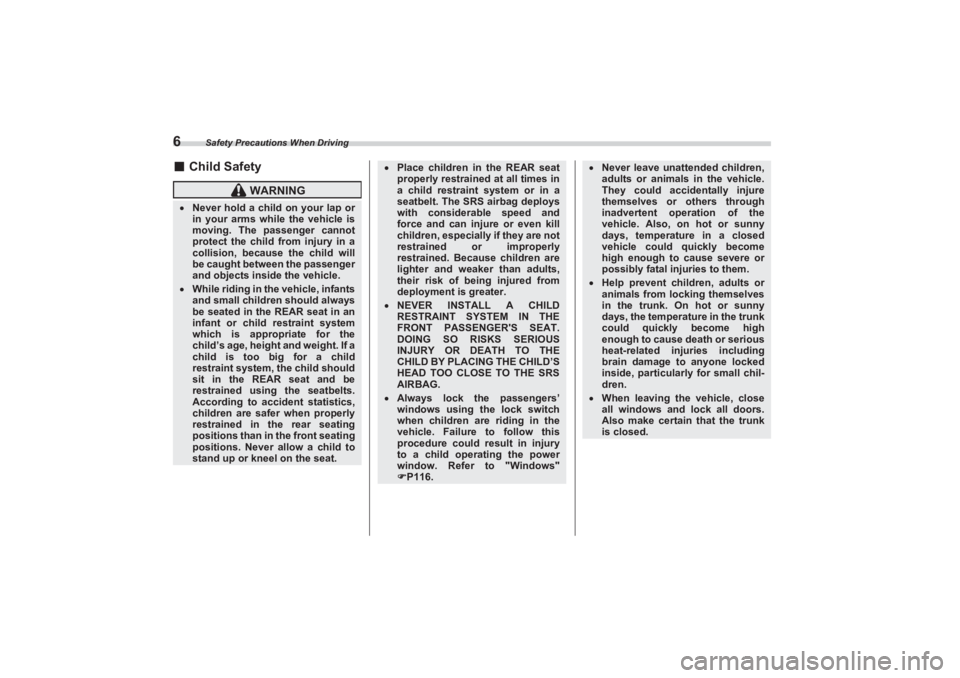
Safety Precautions When Driving
6■Child Safety
WARNING
Never hold a child on your lap or
in your arms while the vehicle is
moving. The passenger cannot
protect the child from injury in a
collision, because the child will
be caught between the passenger
and objects inside the vehicle. While riding in th e vehicle, infants
and small children should always
be seated in the REAR seat in an
infant or child restraint system
which is appropriate for the
child’s age, height and weight. If a
child is too big for a child
restraint system, the child should
sit in the REAR seat and be
restrained using the seatbelts.
According to accident statistics,
children are safer when properly
restrained in the rear seating
positions than in the front seating
positions. Never allow a child to
stand up or kneel on the seat.
Place children in the REAR seat
properly restrained at all times in
a child restraint system or in a
seatbelt. The SRS airbag deploys
with considerable speed and
force and can injure or even kill
children, especially if they are not
restrained or improperly
restrained. Because children are
lighter and weaker than adults,
their risk of being injured from
deployment is greater. NEVER INSTALL A CHILD
RESTRAINT SYSTEM IN THE
FRONT PASSENGER'S SEAT.
DOING SO RISKS SERIOUS
INJURY OR DEATH TO THE
CHILD BY PLACING THE CHILD’S
HEAD TOO CLOSE TO THE SRS
AIRBAG. Always lock the passengers’
windows using the lock switch
when children are riding in the
vehicle. Failure to follow this
procedure could result in injury
to a child operating the power
window. Refer to "Windows"
P116.
Never leave unattended children,
adults or animals in the vehicle.
They could accidentally injure
themselves or others through
inadvertent operation of the
vehicle. Also, on hot or sunny
days, temperature in a closed
vehicle could quickly become
high enough to cause severe or
possibly fatal injuries to them. Help prevent children, adults or
animals from locking themselves
in the trunk. On hot or sunny
days, the temperature in the trunk
could quickly become high
enough to cause death or serious
heat-related injuries including
brain damage to anyone locked
inside, particularly for small chil-
dren. When leaving the vehicle, close
all windows and lock all doors.
Also make certain that the trunk
is closed.
BRZ_U.book 6 ページ 2022年3月29日 火曜日 午後3時59分
Page 35 of 432
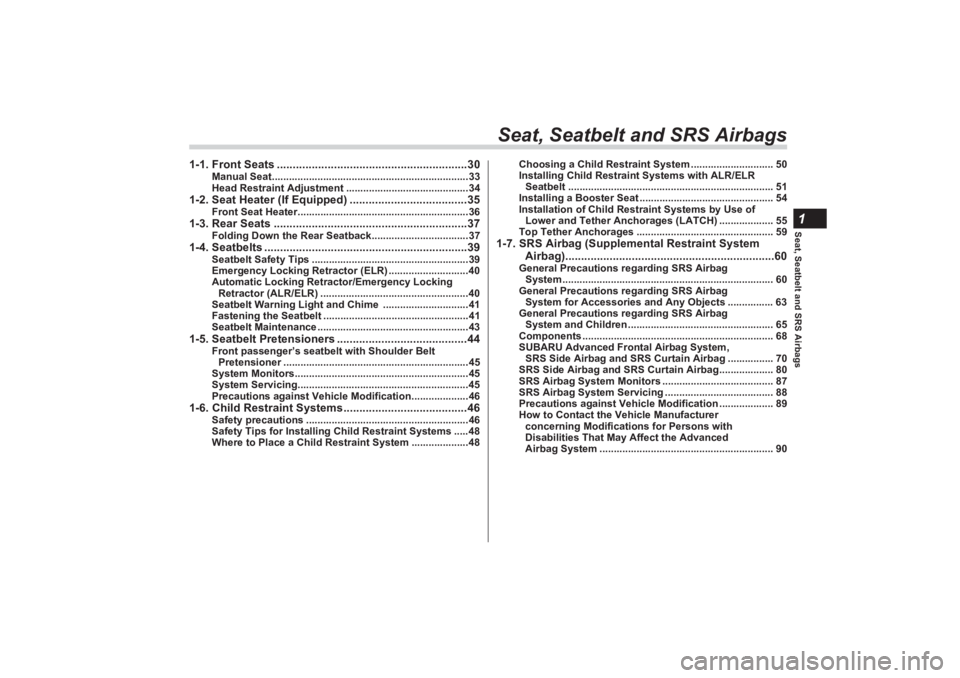
Seat, Seatbelt and SRS Airbags1
Seat, Seatbelt and SRS Airbags
1-1. Front Seats ............................................................30
Manual Seat.....................................................................33
Head Restraint Adjustment ...........................................34
1-2. Seat Heater (If Equipped) .....................................35
Front Seat Heater............................................................36
1-3. Rear Seats .............................................................37
Folding Down the Rear Seatback..................................37
1-4. Seatbelts ................................................................39
Seatbelt Safety Tips .......................................................39
Emergency Locking Retractor (ELR) ............................40
Automatic Locking Retractor/Emergency Locking Retractor (ALR/ELR) .............. ......................................40
Seatbelt Warning Light and Chime ..............................41
Fastening the Seatbelt ...................................................41
Seatbelt Maintenance .....................................................43
1-5. Seatbelt Pretensioners .........................................44
Front passenger’s seatbelt with Shoulder Belt Pretensioner .................................................................45
System Monitors.............................................................45
System Servicing................... .........................................45
Precautions against Vehicle Modification....................46
1-6. Child Restraint System s.......................................46
Safety precautions .........................................................46
Safety Tips for Installing Child Restraint Systems .....48
Where to Place a Child Restraint System ....................48 Choosing a Child Restraint System ............................. 50
Installing Child Restraint Systems with ALR/ELR
Seatbelt ........................................................................ 51
Installing a Booster Seat ............................................... 54
Installation of Child Rest raint Systems by Use of
Lower and Tether Anchorages (LATCH) ................... 55
Top Tether Anchorages ................................................ 59
1-7. SRS Airbag (Supplemental Restraint System
Airbag)..................................................................60
General Precautions regarding SRS Airbag
System.......................................................................... 60
General Precautions regarding SRS Airbag
System for Accessories and Any Objects ................ 63
General Precautions regarding SRS Airbag
System and Children ................................................... 65
Components ................................................................... 68
SUBARU Advanced Frontal Airbag System,
SRS Side Airbag and SRS Curtain Airbag ................ 70
SRS Side Airbag and SRS Curtain Airbag................... 80
SRS Airbag System Monitors ....................................... 87
SRS Airbag System Servicing . ..................................... 88
Precautions against Vehicle Modification ................... 89
How to Contact the Vehicle Manufacturer
concerning Modifications for Persons with
Disabilities That May Affect the Advanced
Airbag System ............................................................. 90
BRZ_U.book 29 ページ 2022年3月29日 火曜日 午後3時59分
Page 46 of 432
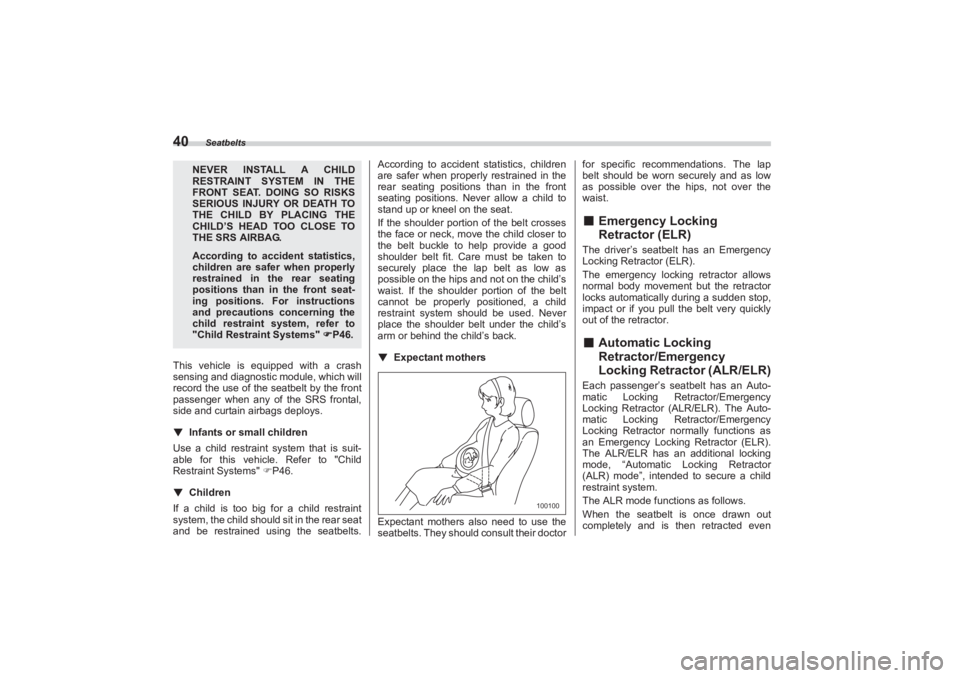
Seatbelts
40This vehicle is equipped with a crash
sensing and diagnostic module, which will
record the use of the seatbelt by the front
passenger when any of the SRS frontal,
side and curtain airbags deploys.▼ Infants or small children
Use a child restraint system that is suit-
able for this vehicle. Refer to "Child
Restraint Systems" P46.
▼ Children
If a child is too big for a child restraint
system, the child should sit in the rear seat
and be restrained using the seatbelts. According to accident statistics, children
are safer when properly restrained in the
rear seating positions than in the front
seating positions. Never allow a child to
stand up or kneel on the seat.
If the shoulder portion of the belt crosses
the face or neck, move the child closer to
the belt buckle to help provide a good
shoulder belt fit. Care must be taken to
securely place the lap belt as low as
possible on the hips and not on the child’s
waist. If the shoulder portion of the belt
cannot be properly positioned, a child
restraint system should be used. Never
place the shoulder belt under the child’s
arm or behind the child’s back.
▼ Expectant mothers
Expectant mothers also need to use the
seatbelts. They should consult their doctor for specific recommendations. The lap
belt should be worn securely and as low
as possible over the hips, not over the
waist.
■ Emergency Locking
Retractor (ELR)The driver’s seatbelt has an Emergency
Locking Retractor (ELR).
The emergency locking retractor allows
normal body movement but the retractor
locks automatically during a sudden stop,
impact or if you pull the belt very quickly
out of the retractor.■ Automatic Locking
Retractor/Emergency
Locking Retractor (ALR/ELR)Each passenger’s seatbelt has an Auto-
matic Locking Retractor/Emergency
Locking Retractor (ALR/ELR). The Auto-
matic Locking Retractor/Emergency
Locking Retractor normally functions as
an Emergency Locking Retractor (ELR).
The ALR/ELR has an additional locking
mode, “Automatic Locking Retractor
(ALR) mode”, intended to secure a child
restraint system.
The ALR mode functions as follows.
When the seatbelt is once drawn out
completely and is then retracted even
NEVER INSTALL A CHILD
RESTRAINT SYSTEM IN THE
FRONT SEAT. DOING SO RISKS
SERIOUS INJURY OR DEATH TO
THE CHILD BY PLACING THE
CHILD’S HEAD TOO CLOSE TO
THE SRS AIRBAG.According to accident statistics,
children are safer when properly
restrained in the rear seating
positions than in the front seat-
ing positions. For instructions
and precautions concerning the
child restraint system, refer to
"Child Restraint Systems" P46.
100100
BRZ_U.book 40 ページ 2022年3月29日 火曜日 午後3時59分
Page 47 of 432
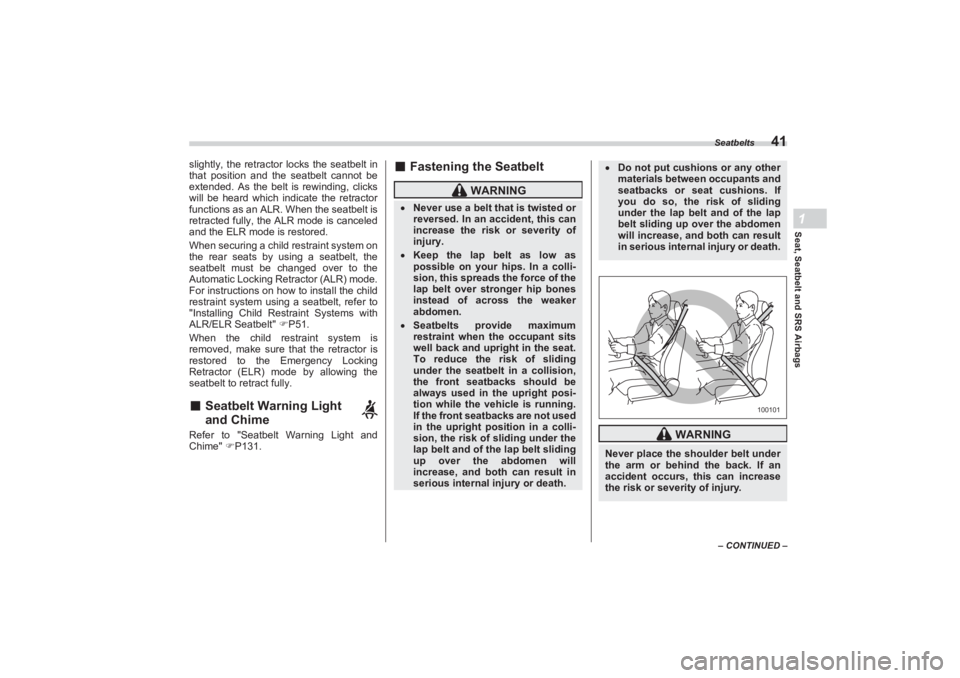
Seatbelts
41
Seat, Seatbelt and SRS Airbags1
– CONTINUED –
slightly, the retractor locks the seatbelt in
that position and the seatbelt cannot be
extended. As the belt is rewinding, clicks
will be heard which indicate the retractor
functions as an ALR. When the seatbelt is
retracted fully, the ALR mode is canceled
and the ELR mode is restored.
When securing a child restraint system on
the rear seats by using a seatbelt, the
seatbelt must be changed over to the
Automatic Locking Retractor (ALR) mode.
For instructions on how to install the child
restraint system using a seatbelt, refer to
"Installing Child Restraint Systems with
ALR/ELR Seatbelt" P51.
When the child restraint system is
removed, make sure that the retractor is
restored to the Emergency Locking
Retractor (ELR) mode by allowing the
seatbelt to retract fully.■ Seatbelt Warning Light
and Chime Refer to "Seatbelt Warning Light and
Chime" P131.
■ Fastening the Seatbelt
WARNING
Never use a belt that is twisted or
reversed. In an accident, this can
increase the risk or severity of
injury. Keep the lap belt as low as
possible on your hips. In a colli-
sion, this spreads the force of the
lap belt over stronger hip bones
instead of across the weaker
abdomen. Seatbelts provide maximum
restraint when the occupant sits
well back and upright in the seat.
To reduce the risk of sliding
under the seatbelt in a collision,
the front seatbacks should be
always used in the upright posi-
tion while the vehicle is running.
If the front seatbacks are not used
in the upright position in a colli-
sion, the risk of sliding under the
lap belt and of the lap belt sliding
up over the abdomen will
increase, and both can result in
serious internal injury or death.
Do not put cushions or any other
materials between occupants and
seatbacks or seat cushions. If
you do so, the risk of sliding
under the lap belt and of the lap
belt sliding up over the abdomen
will increase, and both can result
in serious internal injury or death.
WARNING
Never place the shoulder belt under
the arm or behind the back. If an
accident occurs, this can increase
the risk or severity of injury.
100101
BRZ_U.book 41 ページ 2022年3月29日 火曜日 午後3時59分
Page 53 of 432

Child Restraint Systems
47
Seat, Seatbelt and SRS Airbags1
– CONTINUED –
Children could be endangered in an acci-
dent if their child restraint systems are not
properly secured in the vehicle. When
installing the child re straint system, care-
fully follow the manufacturer’s instruc-
tions.
According to accident statistics, children
are safer when properly restrained in the
rear seating positions than in the front
seating positions.
All U.S. states and Canadian provinces
require that infants and small children be
restrained in an approved child restraint
system at all times while the vehicle is
moving.Lock release button
1) Unlocked
2) Locked
A) Unlocking marker in red
A
12
102671
WARNING
Before installing a child restraint
system, be sure to confirm that
the seatback is securely locked
into place. Otherwise, in an acci-
dent, serious injury or death
could result. Do not leave children in the car
unattended. High interior
temperatures may cause heat
stroke and dehydration that
result in serious injury or death.
100125
WARNING
Never let a passenger hold a child
on his or her lap or in his or her
arms while the vehicle is moving.
The passenger cannot protect the
child (or infant) from injury in a col-
lision, because the child will be
caught between the passenger and
objects inside the vehicle. Addition-
ally, holding a child in your lap or
arms in the front seat exposes that
child to another serious danger.
Since the SRS airbag deploys with
considerable speed and force, the
child could be injured or even killed.
100126
BRZ_U.book 47 ページ 2022年3月29日 火曜日 午後3時59分
Page 55 of 432
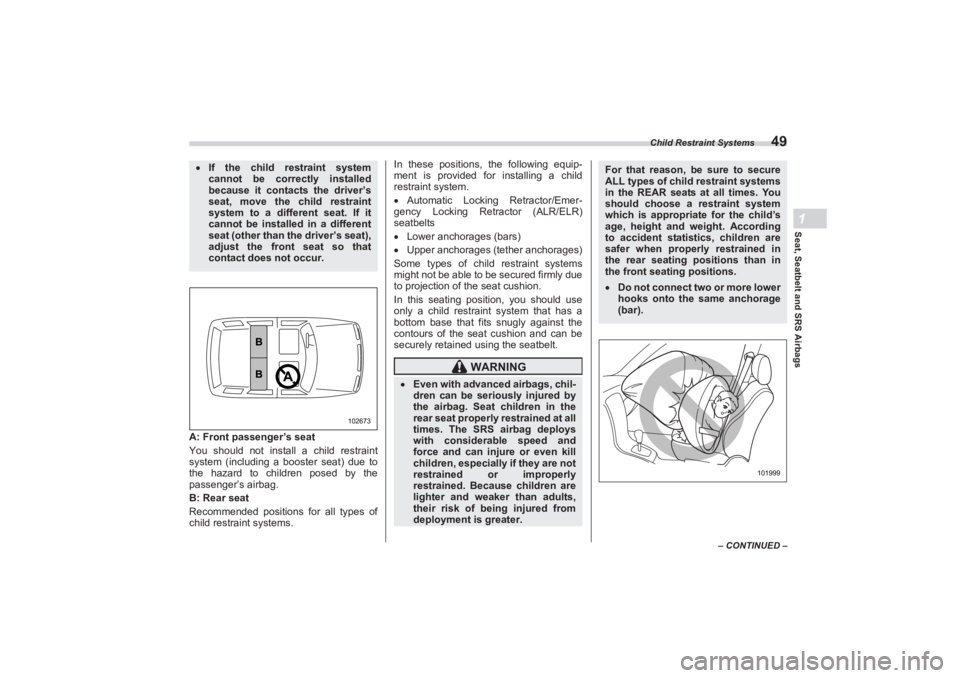
Child Restraint Systems
49
Seat, Seatbelt and SRS Airbags1
– CONTINUED –
A: Front passenger’s seat
You should not install a child restraint
system (including a bo oster seat) due to
the hazard to children posed by the
passenger’s airbag.
B: Rear seat
Recommended positions for all types of
child restraint systems. In these positions, the following equip-
ment is provided for installing a child
restraint system.
Automatic Locking Retractor/Emer-
gency Locking Retractor (ALR/ELR)
seatbelts
Lower anchorages (bars)
Upper anchorages (tether anchorages)
Some types of child restraint systems
might not be able to be secured firmly due
to projection of the seat cushion.
In this seating position, you should use
only a child restrain t system that has a
bottom base that fits snugly against the
contours of the seat cushion and can be
securely retained using the seatbelt. If the child restraint system
cannot be correctly installed
because it contacts the driver’s
seat, move the child restraint
system to a different seat. If it
cannot be installed in a different
seat (other than the driver’s seat),
adjust the front seat so that
contact does not occur.
102673
WARNING
Even with advanced airbags, chil-
dren can be seriously injured by
the airbag. Seat children in the
rear seat properly restrained at all
times. The SRS airbag deploys
with considerable speed and
force and can injure or even kill
children, especially if they are not
restrained or improperly
restrained. Because children are
lighter and weaker than adults,
their risk of being injured from
deployment is greater.
For that reason, be sure to secure
ALL types of child restraint systems
in the REAR seats at all times. You
should choose a restraint system
which is appropriate for the child’s
age, height and weight. According
to accident statistics, children are
safer when properly restrained in
the rear seating positions than in
the front seating positions. Do not connect tw o or more lower
hooks onto the same anchorage
(bar).
101999
BRZ_U.book 49 ページ 2022年3月29日 火曜日 午後3時59分
Page 57 of 432
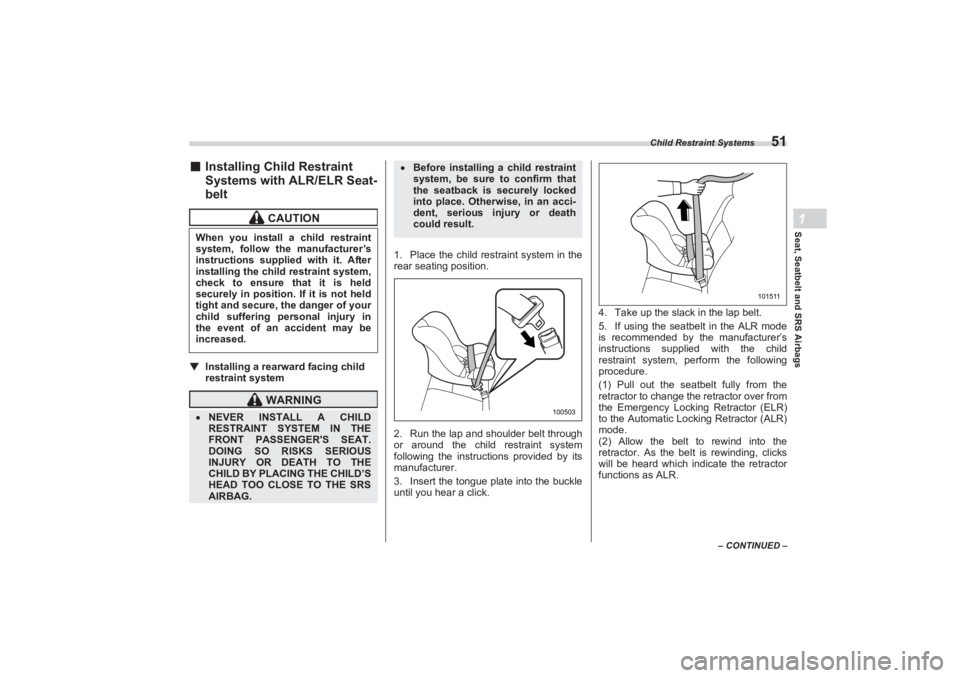
Child Restraint Systems
51
Seat, Seatbelt and SRS Airbags1
– CONTINUED –
■Installing Child Restraint
Systems with ALR/ELR Seat -
belt▼ Installing a rearward facing child
restraint system
1. Place the child rest raint system in the
rear seating position.
2. Run the lap and shoulder belt through
or around the chil d restraint system
following the instructions provided by its
manufacturer.
3. Insert the tongue plate into the buckle
until you hear a click. 4. Take up the slack in the lap belt.
5. If using the seatbelt in the ALR mode
is recommended by the manufacturer’s
instructions supplied with the child
restraint system, perform the following
procedure.
(1) Pull out the seatbelt fully from the
retractor to change the retractor over from
the Emergency Locking Retractor (ELR)
to the Automatic Locking Retractor (ALR)
mode.
(2) Allow the belt to rewind into the
retractor. As the belt is rewinding, clicks
will be heard which indicate the retractor
functions as ALR.
CAUTION
When you install a child restraint
system, follow the manufacturer’s
instructions supplied with it. After
installing the child restraint system,
check to ensure that it is held
securely in position. If it is not held
tight and secure, the danger of your
child suffering personal injury in
the event of an accident may be
increased.
WARNING
NEVER INSTALL A CHILD
RESTRAINT SYSTEM IN THE
FRONT PASSENGER'S SEAT.
DOING SO RISKS SERIOUS
INJURY OR DEATH TO THE
CHILD BY PLACING THE CHILD’S
HEAD TOO CLOSE TO THE SRS
AIRBAG.
Before installing a child restraint
system, be sure to confirm that
the seatback is securely locked
into place. Otherwise, in an acci-
dent, serious injury or death
could result.
100503
101511
BRZ_U.book 51 ページ 2022年3月29日 火曜日 午後3時59分